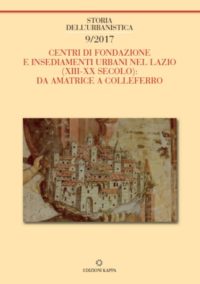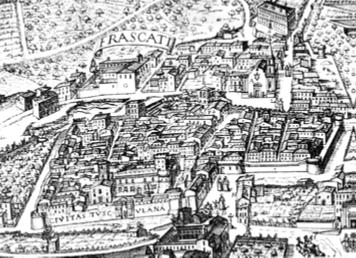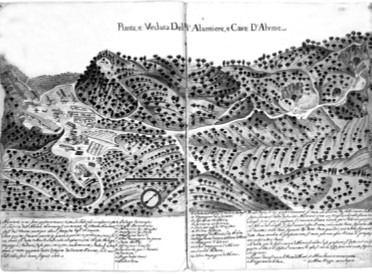IT This page is translated in English
In this issue of “Storia dell’Urbanistica” are published ten contributions dedicated to the creation of as many new foundations, extensions or radical restructurings of settlements in Lazio, among which stands out a broad analysis of the potential of investigation offered, in this historiographical field, from documentation kept in the central and peripheral government archives of the Papal State, local municipalities and, no secondarily, of the families of the feudal nobility belong or high prelates protagonists of important initiatives in the urban field.
This last essay focuses – in particular – on the case of Civitavecchia between the fifteenth and sixteenth centuries, while offering an overview of the centers founded in the region subdivided by extraction of the promoters of such enterprises (feudal settlements or due to the direct will of the popes) or belonging to the sphere of influence of the most important families of the Roman aristocracy (from the Chigi to the Barberini, from the Pamphili to the Rospigliosi).
We are therefore in the presence of an issue that – in consolidating the regular publication of the magazine and its undisputed scientific centrality in the panorama of researches in that field – houses a collection of studies focusing on some episodes of the urban history of the region of particular relevance: from medieval town planning (Amatrice) to those of the XV-XVI centuries (the village of Ostia, the reconstruction of Frascati, the productive settlement of Allumiere and the new towns of Manziana and Monteflavio) and XVII-XVIII (the intervention of the Chigi in Castel Fusano), reaching the threshold of the contemporary age (San Lorenzo alle Grotte and San Lorenzo Nuovo).
The elaboration of these contributions is due to a research project, developed by Enrico Guidoni in the last years of his scientific and academic activity destined to find a first concrete expression – just after his death – in the conference dedicated to “Città nuove e addizioni urbane nel Lazio dal medioevo al novecento”, edited by Giada Lepri and Guglielmo Villa (Oriolo Romano, 7-8 March 2008).
In that occasion, the accent was rightly placed on the fact that the episodes linked to the construction of the new foundation centers or to the expansion of the existing ones coincided, generally, with the experimentation and application of methods and of planning and executive control tools more advanced than those usually used in the interventions of updating or replacement of the existing urban pattern, giving space to the development of models expressing “close correlations with the artistic experiences and the most updated theoretical elaborations” of the corresponding ages.
Within this critical perspective the highly innovative character of the conclusions reached by Guidoni was highlighted, observing how – in that case – they intended to overcome the predominantly local slant of many studies available for Lazio settlement’s, in favor of the adoption of criteria aimed, on one side, to examine the use of the comparative method to the interpretation of chronologically coeval settlements, and on the other, to put the bases for the identification of one or more “evolutionary” branch, able to bring the great variety of settlements models to clear and recognisable projectual and expressive matrix: “The purpose is to make a first recognition of the diachronic variants of the phenomenon, also in relation to the evolution of the reference contest. For this purpose the centers will be analyzed with particular reference to the geometries and to the techniques of the structure and to the configuration of the urban space. Systematic comparisons will be aimed to identify originality and derivations of the design models used and the cultural components that implicate his conception”.
The most important meaning of that way to proceed , to be read also in relation to the totalizing influence exerted, on the whole of these technical-planning experiences, from the extraordinary and inexhaustible reservoir of techniques, architectural and urban models, artistic personalities represented by Rome (which, situated in the center of this political and territorial perimeter, never ceases, since the modern age, to exercise on its domains its attractive force but also its cultural and administrative control, pervasive and overwhelming), is underlined by the reference (Tamblè) to the interpretative reflections that, at the beginning of the Eighties, Guidoni had expressed about the urban planning policy of the Italian regional states.
He had acutely pointed out how this policy led, from the end of the 16th century, to a progressive marginalization of minor centers, which in fact entrusts to the capitals the role of almost exclusive arbitrator “of choices and elaborations, even at an artistic level […] slowly produces [in the case of the papal state] the decline of the quality and the artistic richness of the medium and small centers”, except for “only some particular situations of privilege created by baronial situations” (cfr. Introduzione, on Inchieste su centri minori, ed. by F. Zeri, Torino, Einaudi, 1980, pp. 16 and 18 ), or as emerges from some of the cases here examinated , from what emanates from the direct will of the monarch.
This interpretative scenario, which, after many years, keeps its methodological and disciplinary relevance intact, must be recognized, in light of recent seismic events that have seriously damaged the artistic and settlement heritage of many Lazio, Umbria and Marche towns, a additional irreplaceable value, suitable for the preventive availability of analytical studies equipped with adequate cartographic supports.
This is exactly the case of the Amatrice urban plan, object of an accurate study (Giammarini), which will not fail to positively affect the reconstruction of this center, so devastated by the earthquake of 24 August 2016.
The essays on which we have briefly discussed are accompanied, in the research section, by two essays focusing on an original re-reading in an evolutionary and “functional” sense of the topography of the Roman Forum area between the royal age and late Republican period and some considerations on the birth of the Roman trident and on the role played by Raphael and Antonio da Sangallo Raffaello e by Antonio da Sangallo, with the aim of giving this issue of the magazine contents that are pointed out to the attention of the scientific community for thematic and methodological compactness.


